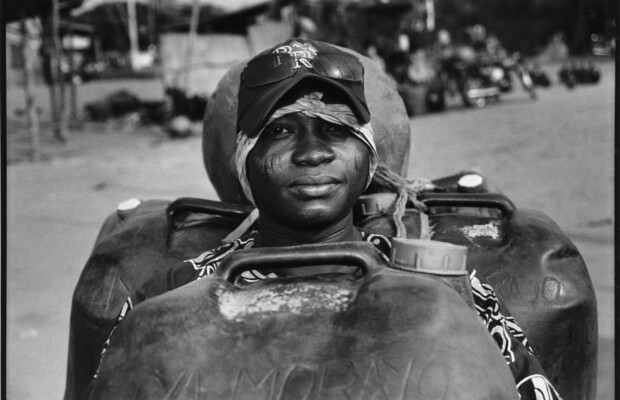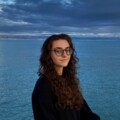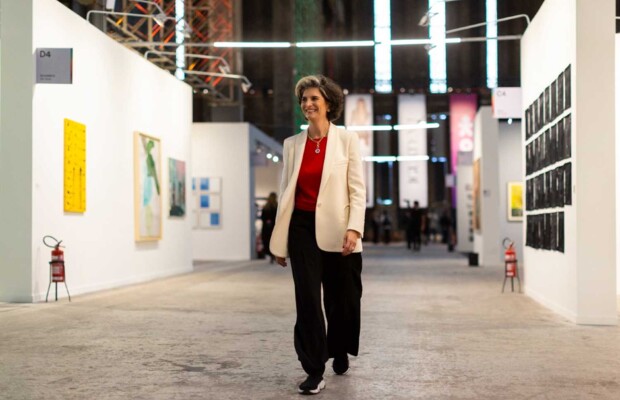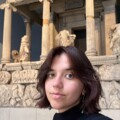Take it or leave it
A conversation with Astrid Oudheusen on process, purpose and compromise
For the past 10 minutes we have been walking through a lot of grey, concrete and corporate despair in the northwest of Amsterdam. Now, we are standing outside of a brick building when a woman with a warm smile and a warm-coloured sweater greets us. Her jeans are a vibrant palette of all the paint you can imagine. It’s Astrid Oudheusen — a Dutch artist, whose works are full of childlike curiosity and playfulness.
The studio, its charming disarray, smell, light and colour — all seem like the best self-portrait an artist can create.



Astrid: So, your questions are prepared? (jokingly)
Anastasiia: Well, it's just the flow of the conversation, because I really want to cover certain topics, especially about you as an artist, but also the industry itself - maybe your opinions on that and I have questions about that specifically.
Astrid: So, how come you are interested in the industry?
Anastasiia: I am an curator for follow.art […] and they're looking for new solutions for artists at the moment, and they're looking for what is lacking, if there's something, if there are tools that artists don't have, or if there's some problems that artists within the community are facing.
So that's, that's what I want to find out.
Astrid: We have to change the whole world, eh? To change [how the things are]. No, because that's the root of the problem. I have been an artist now for eternity… I graduated in 92, so.. 31 years. Yes. No, I'm very bad. No, it's more. 32. And if you're not white, male… that's the main problem.
Because a lot of gallerists, they were interested in my work, but then…I’m always changing, because I really wanted to discover all the, the nukes and the crannies of what my work can do. And then a gallerist would say: “Yeah, but we really like the, the colorful pieces, so can you make more of the colorful pieces?”
The conversation kicks off steeply. I did not expect to hit a nerve when I started talking about the way the artistic industry operates. But it turned out to be one of the leitmotivs of our conversation — the choices artists have to make to accommodate the system, the compromises and the often unfair opportunities.
Astrid: […]”We’re going to make a big star of Willem de Kooning”, and never “we're going to make a big star of Elaine de Kooning”. She was very good. She was a very, I mean, all these American painters, they had wives who were very, very good. But we never saw them because, yeah, they were women. And I think that's still a big problem.
Anastasiia: I was thinking that these days, especially in the Netherlands, that wouldn't be the case because when it comes to those issues, you know, people's voices are heard more, there's more representation, but maybe it’s just on the surface…
Astrid: Maybe on the surface, but I mean, yeah, if you know the right people, your voice gets heard, but…
Anastasiia: It's networking.
Astrid: It's networking. And I want to be in my studio. I don't want to go to all these events. I mean, I don't drink alcohol, so all these … it's not interesting for me. I don't like to get pissed and then: “Ah, you're my buddy!” Can you do something for me? Oh. I'm not that kind of person. Yeah. No, the people need to appreciate my work and that's it.
And I'm not going to beg them to.
Anastasiia: Yeah. But, wouldn't you say, like, online tools have kind of played some role in that. Maybe there has been some shift, because with online platforms, artists have more independence from that type of communication, from that type of…
Astrid: Yeah, but then the online platforms, they work, I mean, they were created, again, by white, male, middle aged men.
So the hashtags and the, yeah, I mean, you have to be very sappy when it comes to the hashtags and stuff like that. And if you don't want to… I mean, yeah, maybe it's a bit of a, an emancipation because, yeah, I make some money through Saatchi and Singulart. But it's still the same, I think. It's still the same.
I don't know. I don't really trust the, the, the hashtag thingy.
Anastasiia: Yeah, I figure it might be a bit… downgrading in a way, for an artist. I mean, you really put a lot in a work and then you have to go to these lengths to push it to people as if it's, I don't know…
Astrid: Yeah, that's why I don't do that.
It's like, oh, you take it or leave it. You take it or leave it. [They are pieces of] my soul. So you should, you should…go down on your knees and thank me for that (ironically). Yeah. Yes, that's, that's true. No, but that would be normal, in my opinion. Yeah. Because it's really, they are all my kids, pieces of me. Yeah. I'm, I'm giving them to the world.
And that's a big thing.
Later in our conversation we touched the issue of the industry again. Astrid expressed her distress about the fact that money becomes the single driver of the artistic process, if you want to survive.
Anastasiia: Oh, you really don’t like the capitalist mindset.
Astrid: No, I hate it. I think it's the biggest curse for the, for, for humanity because it's based upon growth. I mean, eternal growth is impossible. It's cancer. I mean, if you don't stop it, it becomes a bad thing, which is what we're seeing now.
Anastasiia:. It is the same in the art world, isn't it? In the art communities.
Astrid: Yeah, and in capitalist countries, artists are forced to become a trade-, how do you call that? A business person. I'm not a business person! I mean, if I, if I could, I would just give my work away. Why would I, why would I ask money for that? Those are pieces of my soul. I think it's very bad for me to get money for that…
But yeah, ever since I was very small, I was very much against this whole money making capitalist system, but nobody listens to me, unfortunately.
Talking to Astrid, it becomes clear that her vulnerability and honesty truly resemble those of a child. It’s raw and clear — which is mirrored in her works.
Anastasiia: I also wanted to ask you about the way you use color in your work…because the artworks, they often feature very bold colors, and the colors often dominate the composition. Is it an intentional choice to do so?
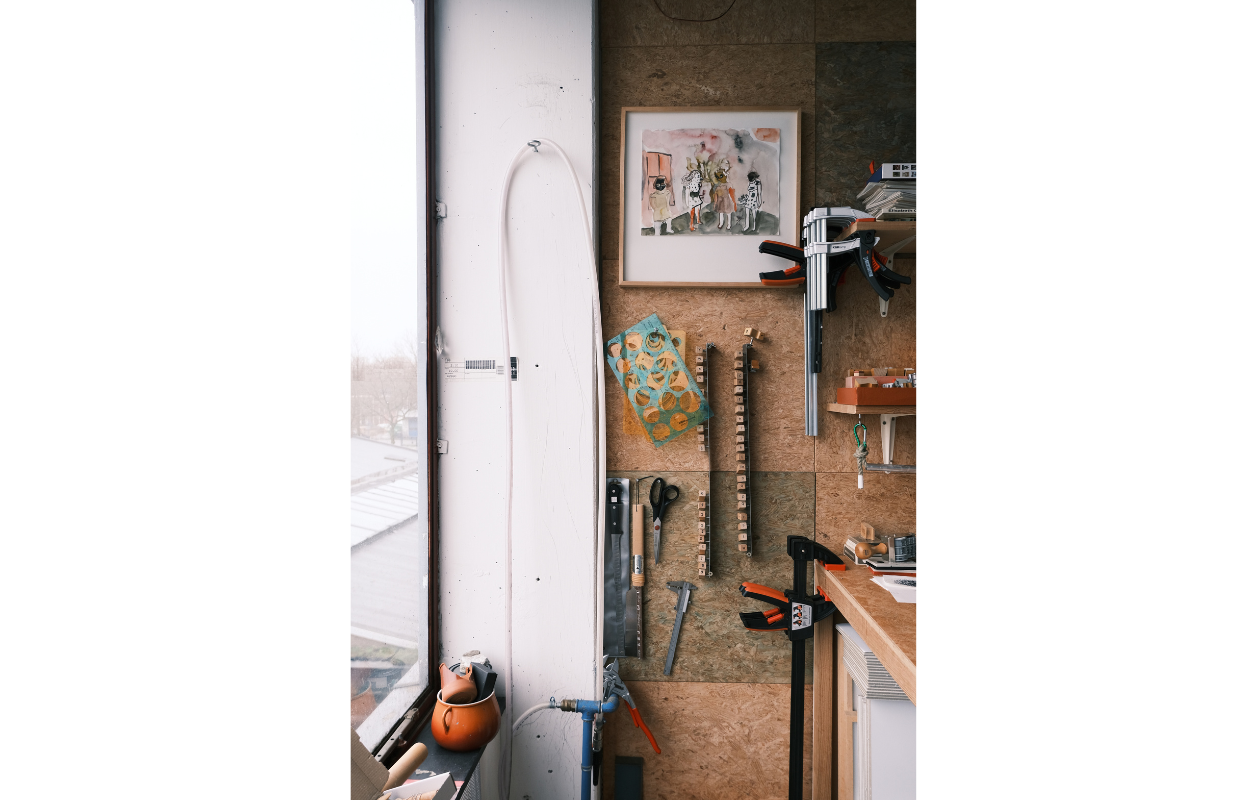
Astrid: No, I never think about what I do. Everything comes from intuition and from feelings. And, I don't think it's a decision I make. It's just that I'm very used to expressing myself through color more than through form. So, you would say I would be a better abstract artist because colors are… I always like to make it interesting for myself as well.
I mean, composition I understand very, very well. Colors I understand very, very well, but with forms I tend to, my fantasy tends to take it over. So when I have to, for example, paint your, your rucksack, I immediately understand the color. I understand where I would put it in the, in the composition, but then the form, something with my fantasy, I don't know, it tells me something different.
Anastasiia: Ah, so you cannot just take it as it is?
Astrid: Immediately there's a story. I wonder, what’s inside the rucksack, and then, I don't know…I can't control that..
Anastasiia: So, suprematism would be like hell for you because it's all forms, it's all straight?
Astrid: Yeah. Absolutely.
Anastasiia: That's beautiful. I also wanted to ask about light, because with realism, this is the thing. We know about, for example, Golden Age painters, right?
Like Rembrandt. We know Rembrandt for his work with light, especially. But when we're talking about contemporary artists, I would say color, form, maybe composition, it's on the front. But light is something that kind of gets lost? Do you put any sort of intention in working with light in your practice?
Astrid: I think about it. I mean, I notice it, I'm aware of it. Um, but since I don't paint after nature, there's no…
Anastasiia: Ah, so it's always a mental image.
Astrid: Yeah, and then if I would be painting after nature, it probably… No, I don't think light as as a subject really interests me in the, in, in the painting.
I mean, I, I know that it's there and I would sometimes use it, but it's not my…
Anastasiia: …focus.
Astrid: No, I'm not like that. I like the Northern light. I like the daylight. But in my paintings, it's mostly form, it's composition and it's color. I think I'm very much a storyteller. If we look at some of my works, I do things with shadow and light.
There's light falling on him. There's light falling on her. Yeah, over here as well, but it's very different from what a classical painter would do, but I'm aware of it.
Anastasiia: You said you don't paint, paint after nature usually, but do you paint from personal experiences or…?
Astrid: Um, it's not a thinking process, it's something that comes into being. So, I start with with an empty canvas, and then something pops up, it just materializes.
Often, it can be something I heard in the street, or, or saw in the park, in the store…I don't know, a piece of a conversation between two people that goes on in my mind. Oh, things like that. It can be anything. Or a funny dog.
With the big paintings…I used to work in series. [For example] it was people from the neighborhood, because there's a lot of office workers over here. And they, they walk the street between twelve and two, I think. And they almost all look very unhappy. I made a series about people working in offices, but wanting to do something else. You can see that they want to be a rock star or something like that.
But now, for some reason, I don't do series now. There's just people popping up in the landscapes.
Anastasiia: A lot of time, when you feature a portrait of a person, I don't know, the way that you put it, the face, it always seems like there's a story…Like, you have a series called, I think, “American”, right? Were they just American people or..? It was very interesting to me how you depicted their faces,…it was a very eerie way of looking at a person.



Astrid: Yeah. I've had some American friends who didn't like the series. They were like: “ you're depicting us in a very, very bad way”.
At that time, I made a thousand self portraits. I was very depressed and the only way to keep living was by painting. So I made a thousand self portraits and then as a sort of investigation… because those self portraits were very much about the inside, my inner world.
And I wanted to, uh, paint pictures of portraits of people who felt very much opposed to me. I don't know if it's really possible for people to be opposed to me, because I'm, I'm, you know, I'm a people lover. I really like to talk to people. But I picked the Americans because in the way they live, they feel very far removed from me.
I mean, they're in their cars, they tend to live very much on the surface. I mean, your life is good as long as you have a mortgage, a car, a job, a husband or a wife. And that's so much not as I live. […]
And that’s why they tend to look like that.
How Astrid describes her process, her approach is, in my opinion, what separates artists of form and artists of content. She is clearly the latter type — not overconsumed with how her works “come into being”, but very attentive to transformations and dwellings in her inner world.
She told me that she has identified as an artist since she was 5 years old and it was crystal clear to her that this is why she came to this world. It’s her calling, her purpose. She did not go to art school to “learn art”, art was a part of her long before that. I became curious: could someone with such an intrinsic feeling of their profession become an educator? Because a teacher is someone who explains “how”. And it must be hard to answer the question if you never ask it to yourself.


Anastasiia: Have you ever, uh, done painting, drawing, art, as a tutor… have you ever taught anyone that?
Astrid: Yes, I was a tutor in Eindhoven, at the Design Academy.
Anastasiia: And did you like that experience?
Astrid: Yeah, I really loved it. I loved being a… yeah, it was great. Uh, I did it for six years, for seven years. You know, I'm not aware of how much I know, but I know a lot because I've been painting since forever.
So the moment you put me in front of a group of students, there's this immediate interaction and I really like it. Yeah, I loved it. I loved it. But I quit because it's too far. It's like one and a half hour and, and they pay sh*t and they treat the staff like sh*t.
But for the students, I would start tomorrow again. I loved it. It was so great. Yeah. It's great to give it back, exchange.
Because they already know a lot of things and they come from a different generation. So, it's interesting to talk to them, it's really exciting to hear their ideas about what the world is going to be like and what needs to change.
Anastasiia: And did you teach a specific course?
Astrid: Yeah, my course was about the inner world.
Anastasiia: The inner world.
Astrid: And how to sort of transfer it to the canvas. Because it's a design academy, so people who go there, they're very much in their head. And they tend to solve anything they have to make with their heads first. So I was the tutor who would give them an insight in how you can start from feeling. And from your intuition. Instead of “I have this idea and I'll write about it and then I'll work it”.
Anastasiia: And have you ever thought about going into the online education realm? You know, there are a lot of opportunities nowadays.
Astrid: No, I don’t think it’s my cup of tea. Well, I wouldn't mind teaching, but the thing I do, it only works when I have a connection.
Yeah, when I have a connection, when there's a student I do everything on feeling. I don't do it by thinking about, “ah, we need to make sure that we have all these topics checked”. It's just, like I said, put me in front of students and something will come out. But it's so intuitive.
And I can't do that with a video. I mean, I've made some little films when you see me drawing. You can always see my hand... and yeah. But I wouldn't, no, I wouldn't be interested in online education, because I don't work that way. If I paint or if I draw, it comes. And afterwards, I can tell you, “ah, okay, yeah, that was about my dream”, but while I'm doing it, I have no clue, my heart knows.
Astrid was born in 1967 and yet, her vision, her approach is as fresh and pure as that of an 8 year old. In a world where business drives artistic success, she feels out of place. But she holds her ground steadily, and however controversial they may seem, her opinions are honest and uncensored. I believe true art is not born out of compromise and accommodation, it just comes into being in its rawness. And you either “take it or leave it”.

Visit the On being human and human being exhibition curated by Anastasiia Savilova featuring Astrid Oudheusen's works.
All photos are courtesy of Olga Kovalenko (Instagram: @cant_c0mpete)
Share the post:




